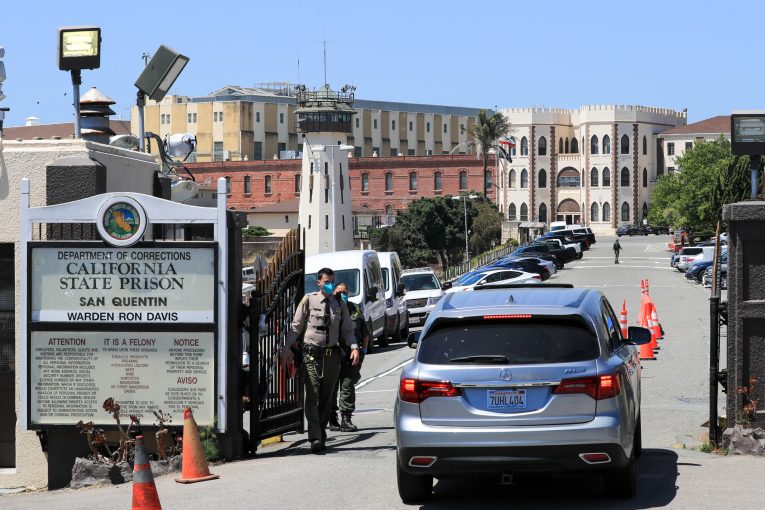
 By Steve Brooks
By Steve Brooks
At San Quentin State Prison (SQ), a musical symphony of hoarse voices, hacking coughs and the clearing of congested nasal passages is signaling another outbreak of COVID-19.
The new Omicron variant, which reportedly broke out in SQ’s Alpine and H-Units early January, is now spreading throughout the North and West Block housing units even though the prison was placed on a 15-day lockdown last week along with other California prisons.
Prisoners are blaming staff for bringing COVID-19 back in. “Staff are the only ones who can bring it in,” prisoner Arthur Jackson said. “They’re working all over the prison. They’re searching cells all the time. They’re not just bringing it [into] the prison, but in our cells.”
California correctional officers are also not, as of a Nov. 26 federal court ruling, required to get vaccinated, and not all are tested, which means officers who are asymptomatic but positive may be reporting to work.
“They have had ample opportunity to bring Omicron into other buildings and make this quarantine useless,” Jackson said.
According to a Jan. 11 article in the Marin Independent Journal, there had only been six active COVID-19 cases among prisoners and 83 among staff in the previous two weeks. But on Jan. 21, the California Department of  Corrections and Rehabilitation (CDCR) COVID-19 tracker recorded 255 active prisoner cases and 91 active staff cases at SQ. Between Dec. 26 and Jan. 9, cases among prisoners statewide increased by more than eight times.
Corrections and Rehabilitation (CDCR) COVID-19 tracker recorded 255 active prisoner cases and 91 active staff cases at SQ. Between Dec. 26 and Jan. 9, cases among prisoners statewide increased by more than eight times.
This latest outbreak comes just about two months after a Marin court judge ruled that prison officials inflicted cruel and unusual punishment on prisoners at SQ during a massive COVID-19 outbreak that killed 29 people and infected more than 2,600 in the summer of 2020.
As of yet, no one has gotten seriously ill this time around. What appears to be saving the lives of prisoners at SQ is the fact that many of us have already had COVID-19, and have taken two vaccines plus a booster shot. Those incarcerated at SQ have a 91% vaccination rate, according to CDCR.
Nevertheless, nurses have been walking the tiers to do wellness checks and asking prisoners to take tests. Many are refusing out of fear of being isolated.
According to Michael Mizuo, an Inmate Advisory Council representative, prison officials have said that those who test positive would be placed in isolation for at least 10 days. Prisoners in North Block would also stay in quarantine for an additional 14 days. It’s a Catch-22 for prisoners.
“They said that lots of people aren’t testing and that people need to start taking the COVID-19 tests or the quarantine will last longer,” Mizuo said, after attending a recent meeting with SQ’s associate warden and Chief Medical Officer Allison Pachinski.
According to CDCR’s website, only 61% of SQ’s prisoner population have been tested in the last two weeks.
In many ways, life at SQ has continued as usual. Officers are ordering workers in the main kitchen to report to their shifts even if they have the virus or have been exposed to it.
“They told me I had to go to work, but I could choose which shift,” said Jerry Gearin, who caught COVID-19 in 2020 and almost died.
“What can we do?,” asked Jonathan Jimenez, another kitchen worker who had previously caught COVID-19.
Gearin and Jimenez are two of the lucky ones, since some kitchen workers had died during the 2020 outbreak.
Still, they said their jobs were an opportunity to get out of their cramped cells. The kitchen offers freedom of movement, a daily shower, extra food and 24 cents an hour of pay.
Just as in 2020, however, overcrowding may be helping to fuel this outbreak. Over a year ago, an appeals court ordered San Quentin to cut its population in half to 1,775 prisoners, but a California Superior Court judge put that order on hold last October, prompting prison officials to maintain a population that is currently over 3,100. That number may rise even further.
Many of the same, unsafe conditions that led the Superior Court judge to find that officials inflicted “cruel and unusual punishment” on SQ prisoners still exist today. Most cells are double occupancy, meaning that two cellmates share a space of less than 50 square feet. Prisoners are sitting in these cramped cells 22 to 24 hours a day, reducing them to near solitary confinement conditions.
“North Block is so packed you can’t walk without bumping into someone,” prisoner Earnest Woods said. “When I walk back and forth to the chow hall I have to navigate through a crowd like I’m at a concert.”
During shower times, which are conducted every three days, upward of fifty people pack into the tight shower space for 30 minutes at a time, before officers let out the next tier.
“The ventilation system still isn’t fixed,” prisoner Lecedric Johnson commented. “Windows are still welded shut and doors are kept closed.”
Johnson was also hospitalized when he caught COVID-19 in 2020.
While Omicron has not resulted in the tragedy of the 2020 outbreak, the fear is that the next outbreak won’t be as benign.
“What will happen if we get a variant the vaccines can’t help us with?” Woods asked. “I guess we’re just waiting to see if we die here.”
Originally Published by the Prison Journalism Project. Prison Journalism Project trains incarcerated writers to become journalists and publishes their stories.
